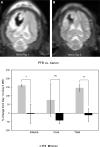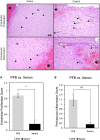Can Ultrasound-Guided Xenon Delivery Provide Neuroprotection in Traumatic Brain Injury?
- PMID: 35317306
- PMCID: PMC8935480
- DOI: 10.1089/neur.2021.0070
Can Ultrasound-Guided Xenon Delivery Provide Neuroprotection in Traumatic Brain Injury?
Abstract
Traumatic brain injury (TBI) is associated with high mortality and morbidity in children and adults. Unfortunately, there is no effective management for TBI in the acute setting. Rodent studies have shown that xenon, a well-known anesthetic gas, can be neuroprotective when administered post-TBI. Gas inhalation therapy, however, the approach typically used for administering xenon, is expensive, inconvenient, and fraught with systemic side effects. Therapeutic delivery to the brain is minimal, with much of the inhaled gas cleared by the lungs. To bridge major gaps in clinical care and enhance cerebral delivery of xenon, this study introduces a novel xenon delivery technique, utilizing microbubbles, in which a high impulse ultrasound signal is used for targeted cerebral release of xenon. Briefly, an ultrasound pulse is applied along the carotid artery at the level of the neck on intravenous injection of xenon microbubbles (XeMBs) resulting in release of xenon from microbubbles into the brain. This delivery technique employs a hand-held, portable ultrasound system that could be adopted in resource-limited environments. Using a high-fidelity porcine model, this study demonstrates the neuroprotective efficacy of xenon microbubbles in TBI for the first time.
Keywords: microbubbles; neuroprotection; traumatic brain injury; ultrasound; xenon.
© Misun Hwang et al., 2022; Published by Mary Ann Liebert, Inc.
Conflict of interest statement
No competing financial interests exist.
Figures


Similar articles
-
Brain Targeted Xenon Protects Cerebral Vasculature After Traumatic Brain Injury.J Neurotrauma. 2023 Jul;40(13-14):1470-1480. doi: 10.1089/neu.2022.0468. Epub 2023 May 4. J Neurotrauma. 2023. PMID: 36927088
-
Characterization and Imaging of Lipid-Shelled Microbubbles for Ultrasound-Triggered Release of Xenon.Neurotherapeutics. 2019 Jul;16(3):878-890. doi: 10.1007/s13311-019-00733-4. Neurotherapeutics. 2019. PMID: 31020629 Free PMC article.
-
Neuroprotection against traumatic brain injury by xenon, but not argon, is mediated by inhibition at the N-methyl-D-aspartate receptor glycine site.Anesthesiology. 2013 Nov;119(5):1137-48. doi: 10.1097/ALN.0b013e3182a2a265. Anesthesiology. 2013. PMID: 23867231
-
Inhalational Gases for Neuroprotection in Traumatic Brain Injury.J Neurotrauma. 2021 Oct 1;38(19):2634-2651. doi: 10.1089/neu.2021.0053. Epub 2021 Jun 8. J Neurotrauma. 2021. PMID: 33940933 Free PMC article.
-
Neuroprotective Properties of Xenon.Mol Neurobiol. 2020 Jan;57(1):118-124. doi: 10.1007/s12035-019-01761-z. Epub 2019 Nov 22. Mol Neurobiol. 2020. PMID: 31758401 Review.
Cited by
-
Anesthetics in pathological cerebrovascular conditions.J Cereb Blood Flow Metab. 2025 Jan;45(1):32-47. doi: 10.1177/0271678X241295857. Epub 2024 Oct 25. J Cereb Blood Flow Metab. 2025. PMID: 39450477 Free PMC article. Review.
References
-
- Heron, M., Sutton, P.D., Xu, J., Ventura, S.J., Strobino, D.M., and Guyer, B. (2010). Annual summary of vital statistics: 2007. Pediatrics 125, 4–15. - PubMed
-
- Chelly, H., Chaari, A., Daoud, E., Dammak, H., Medhioub, F., Mnif, J., Hamida, C.B., Bahloul, M., and Bouaziz, M. (2011). Diffuse axonal injury in patients with head injuries: an epidemiologic and prognosis study of 124 cases. J. Trauma 71, 838–846. - PubMed
-
- McIntosh, T.K., Smith, D.H., Meaney, D.F., Kotapka, M.J., Gennarelli, T.A., and Graham, D.I. (1996). Neuropathological sequelae of traumatic brain injury: relationship to neurochemical and biomechanical mechanisms. Lab. Invest. 74, 315–342. - PubMed
-
- Gennarelli, T.A. (1993). Mechanisms of brain injury. J. Emerg. Med. 11, Suppl 1, 5–11. - PubMed
-
- Gennarelli, T.A. (1997). The pathobiology of traumatic brain injury. Neuroscientist 3, 73–81.
Grants and funding
LinkOut - more resources
Full Text Sources
